Brad's Introduction to Ancient Coins
A coin's grade is an indication of the amount of wear on a particular coin.
This is one factor affecting the value of a coin. Since supply and demand
determine coin prices, like most other commodities, the interest in
a coin type and its availability set the price. But two coins
of the same type, different only in the wear present on the coin,
will differ in price, possibly by a very large amount.
In the US, ancient coins are assigned one of the following grades,
with their common abbreviations shown in parentheses:
Mint State (MS), Extremely Fine (EF or XF), Very Fine (VF),
Fine (F), Very Good (VG), Good (G), and Poor (P).
As you can see, Good, being near the bottom of the list,
is not that good after all -- at least in the coin grading world.
While grading only takes wear into account, a coin's overall
condition also looks at defects (e. g., cracks, edge
damage, corrosion), centering, and strike (whether the coins was produced
with all the detail of the die it was struck with). All of these,
along with the rarity, and the style of art of a coin, affect its price.
But the rest of this page will concentrate on grading alone.
Grades
Mint State (MS)
Mint State coins have been preserved exactly as they were struck.
These command a substantial premium over other coins of the same type.
I don't own any ancient coins that can be fairly described as
mint state.
Extremely Fine (EF or XF)
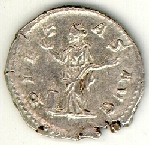 Extremely Fine coins show only a small amount wear on the high points.
All of the inscription should be easily readable, where present.
If the coin is off-center, some of the inscription may be missing.
At first glance, an EF coin will appear not to be worn,
but upon closer inspection, the finer details will show some wear.
The coin shown to the right is EF, but scans of coins often do not
show the detail well. As mentioned before, the damage to the edge
of a coin, such as this one, affects the desirability and price,
but not the grade of the coin. It should, of course, be mentioned
by someone describing the coin for sale.
Extremely Fine coins show only a small amount wear on the high points.
All of the inscription should be easily readable, where present.
If the coin is off-center, some of the inscription may be missing.
At first glance, an EF coin will appear not to be worn,
but upon closer inspection, the finer details will show some wear.
The coin shown to the right is EF, but scans of coins often do not
show the detail well. As mentioned before, the damage to the edge
of a coin, such as this one, affects the desirability and price,
but not the grade of the coin. It should, of course, be mentioned
by someone describing the coin for sale.
Very Fine (VF)

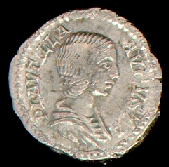 A Very Fine coin shows significant wear, but is still an attractive
and desirable piece in most cases. About two-thirds of the detail
should be present. All of the inscription should be readable, where present.
Note the significant amount of wear in the hair of the first coin
shown to the right. Yet the inscription and many of the lines
of hair are clearly seen (especially when viewing this coin in person).
Note also that this coin has few defects. It is well-centered
and has no edge damage, so it is a very attractive coin for its grade.
The coin further to the right shows a little less detail,
especially in the higher relief area of the empress' hair.
Since it is not quite up to the standard for Very Fine, we
would call it "about Very Fine" or aVF, for short.
A Very Fine coin shows significant wear, but is still an attractive
and desirable piece in most cases. About two-thirds of the detail
should be present. All of the inscription should be readable, where present.
Note the significant amount of wear in the hair of the first coin
shown to the right. Yet the inscription and many of the lines
of hair are clearly seen (especially when viewing this coin in person).
Note also that this coin has few defects. It is well-centered
and has no edge damage, so it is a very attractive coin for its grade.
The coin further to the right shows a little less detail,
especially in the higher relief area of the empress' hair.
Since it is not quite up to the standard for Very Fine, we
would call it "about Very Fine" or aVF, for short.
Fine (F)
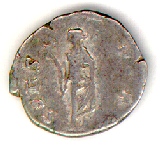
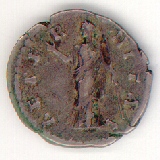 A coin with a grade of Fine has about one-quarter of the fine detail
present. Most or all of the inscriptions should be readable,
though some of the letters may be quite worn.
Most of the detail of the coin at near right has been worn away.
Yet you can clearly see that it is a standing figure, with
an arm pointing to the left. Though it doesn't show clearly
in the scan, the inscription
AETERNITAS
is easily read with the coin in hand.
The coin further to the right is quite worn,
and might be considered a little weak for the grade of Fine.
It also has slight edge damage, but that is a separate issue
from the "technical" grade.
A coin with a grade of Fine has about one-quarter of the fine detail
present. Most or all of the inscriptions should be readable,
though some of the letters may be quite worn.
Most of the detail of the coin at near right has been worn away.
Yet you can clearly see that it is a standing figure, with
an arm pointing to the left. Though it doesn't show clearly
in the scan, the inscription
AETERNITAS
is easily read with the coin in hand.
The coin further to the right is quite worn,
and might be considered a little weak for the grade of Fine.
It also has slight edge damage, but that is a separate issue
from the "technical" grade.
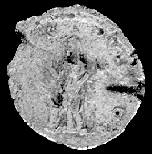 Very Good (VG)
Very Good (VG)
Coins graded Very Good show very heavy wear over the entire surface
of the coin. The outline of the main design, however, should be easily seen.
In most cases, much of the inscription will be legible, though many of
the letters may be quite weak, and some letters may be completely
worn away. To identify a coin in Very Good or lower
will take much experience. With exposure to many, many coins, and
with access to references, you may be able to determine full
inscriptions from just a few letters, with help from the design
on the coin. For example, a common fourth-century reverse design has
an emperor on a horse spearing a soldier on the ground.
This reverse often has the inscription
FEL TEMP REPARATIO.
With only a couple letters visible, a collector who has seen
many of these types of coins will know right away what the
complete inscription is.
Good (G)
A Good coin is not very good at all.
Some of the outline of the design may be present,
but not much. Few, if any letters in the
inscription will be visible.
A coin in this condition is generally
worth very little, unless it is a rare variety.
Poor (P)
Poor is the bottom of the barrel.
The coin has not detail, and is
virtually a smooth disc.
No identification is possible.
Split Grades
Often the obverse and reverse of a coin show
a different amount of wear.
In these cases, the grades for eachs side
are shown, as in VF/F.
The first grade listed is for the obverse.
When a coin is between two grades,
some dealers will list both separated
by a hyphen, as in F-VF.
Unless a / is present, this applies to both sides of the coin.
Full Descriptions of Condition
A coin listed at auction should have a detailed description
of its condition (in addition to identifying information).
Some examples from an auction are shown below:
-
VF, well-centered on large flan, brown patina
-
EF, well-centered, reverse a little off-centered
-
AVF/VF, minor edge crack, attractive portrait.
-
F+, obverse slightly off-center on irregular flan, green patina.
Go back to Brad's Introduction to Ancient Coins.
If you have any questions or comments, please
send e-mail to me at
 .
.
Last updated January 28, 2001.
visitors.
 Extremely Fine coins show only a small amount wear on the high points.
All of the inscription should be easily readable, where present.
If the coin is off-center, some of the inscription may be missing.
At first glance, an EF coin will appear not to be worn,
but upon closer inspection, the finer details will show some wear.
The coin shown to the right is EF, but scans of coins often do not
show the detail well. As mentioned before, the damage to the edge
of a coin, such as this one, affects the desirability and price,
but not the grade of the coin. It should, of course, be mentioned
by someone describing the coin for sale.
Extremely Fine coins show only a small amount wear on the high points.
All of the inscription should be easily readable, where present.
If the coin is off-center, some of the inscription may be missing.
At first glance, an EF coin will appear not to be worn,
but upon closer inspection, the finer details will show some wear.
The coin shown to the right is EF, but scans of coins often do not
show the detail well. As mentioned before, the damage to the edge
of a coin, such as this one, affects the desirability and price,
but not the grade of the coin. It should, of course, be mentioned
by someone describing the coin for sale.

 A Very Fine coin shows significant wear, but is still an attractive
and desirable piece in most cases. About two-thirds of the detail
should be present. All of the inscription should be readable, where present.
Note the significant amount of wear in the hair of the first coin
shown to the right. Yet the inscription and many of the lines
of hair are clearly seen (especially when viewing this coin in person).
Note also that this coin has few defects. It is well-centered
and has no edge damage, so it is a very attractive coin for its grade.
The coin further to the right shows a little less detail,
especially in the higher relief area of the empress' hair.
Since it is not quite up to the standard for Very Fine, we
would call it "about Very Fine" or aVF, for short.
A Very Fine coin shows significant wear, but is still an attractive
and desirable piece in most cases. About two-thirds of the detail
should be present. All of the inscription should be readable, where present.
Note the significant amount of wear in the hair of the first coin
shown to the right. Yet the inscription and many of the lines
of hair are clearly seen (especially when viewing this coin in person).
Note also that this coin has few defects. It is well-centered
and has no edge damage, so it is a very attractive coin for its grade.
The coin further to the right shows a little less detail,
especially in the higher relief area of the empress' hair.
Since it is not quite up to the standard for Very Fine, we
would call it "about Very Fine" or aVF, for short.

 A coin with a grade of Fine has about one-quarter of the fine detail
present. Most or all of the inscriptions should be readable,
though some of the letters may be quite worn.
Most of the detail of the coin at near right has been worn away.
Yet you can clearly see that it is a standing figure, with
an arm pointing to the left. Though it doesn't show clearly
in the scan, the inscription
AETERNITAS
is easily read with the coin in hand.
The coin further to the right is quite worn,
and might be considered a little weak for the grade of Fine.
It also has slight edge damage, but that is a separate issue
from the "technical" grade.
A coin with a grade of Fine has about one-quarter of the fine detail
present. Most or all of the inscriptions should be readable,
though some of the letters may be quite worn.
Most of the detail of the coin at near right has been worn away.
Yet you can clearly see that it is a standing figure, with
an arm pointing to the left. Though it doesn't show clearly
in the scan, the inscription
AETERNITAS
is easily read with the coin in hand.
The coin further to the right is quite worn,
and might be considered a little weak for the grade of Fine.
It also has slight edge damage, but that is a separate issue
from the "technical" grade.
 Very Good (VG)
Very Good (VG) .
.